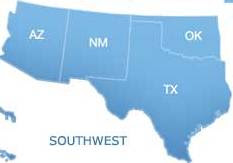Geographic units, population groups, and facilities where residents have substandard access to mental health care services can be designated as a health professional shortage area (HPSA) by the Health Resources and Services Administration (HRSA). This designation can be based on either the size of the HPSA's population relative to (a) the number of psychiatrists that serve the community, or (b) the combined number of psychiatrists, clinical social workers, clinical psychologists, and certain other types of mental health care practitioners who service the area. A shortfall indicates that the number of actual practitioners serving the HPSA is lower than what would be expected for the number of residents living in the designated area.
Based on March 31, 2025 HRSA data, nearly 122.4 million Americans lived in mental health HPSAs. That included 18.7 million residents of the four-state U.S. Southwest. To eliminate the mental health care shortfall in the Southwest, the HRSA estimated that an additional 937 mental health care practitioners would be needed to service mental health HPSAs in the region. A state-level look at HRSA data as of March 31, 2025 reveals the following about the mental health care shortfall in the Southwest:
 | |
The Mental Health Care Shortfall in the Southwest |
| State | (1) HPSAs | (2) Population | (3) Shortfall |
| AZ | 206 | 2,074,757 | 144 |
| NM | 96 | 1,362,121 | 73 |
| OK | 129 | 1,911,019 | 106 |
| TX | 382 | 13,394,834 | 614 |
| Region | 813 | 18,742,731 | 937 |
| U.S. | 6,418 | 122,383,988 | 6,202 |
No comments:
Post a Comment
Let us know what you think about today's commentary!